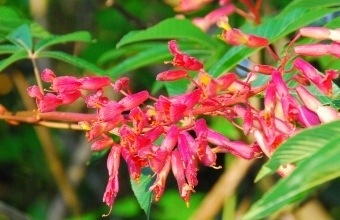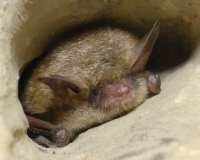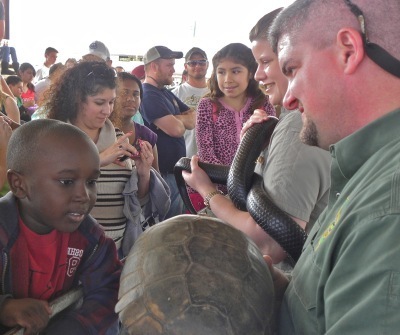
Want to hang with the fastest falcons in Atlanta?
You can through a new DNR camera that live-streams peregrine falcons nesting on SunTrust Plaza!
Watch the stream at www.georgiawildlife.com/FalconCam and on Ustream.
This fascinating look at raptors that make dives at up to 200 mph is provided through a grant from TERN, friends group of DNR’s Nongame Conservation Section, and key support from the law firm McKenna Long & Aldridge, with offices overlooking the nest, and The Garden Club of Georgia Inc.
Watch the birds – they have four eggs now! – comment via Ustream’s Social Stream, or learn more about peregrines and how to help conserve rare wildlife in Georgia.
Peregrines were removed from the federal list of threatened and endangered species because of a successful population recovery effort. Yet the birds are still state-listed as rare in Georgia.
Falcons have been nesting at SunTrust Plaza since 1997. The live-streamed nest is one of three known peregrine nesting territories in Georgia, all of which are in metro Atlanta.
Viewing tips
- If the video stream freezes, try toggling between full- and small-screen, or refreshing the page.
- Lights on the building allow for viewing the nest at night.
- Although the stream is available in HD, the quality you see is determined by your Internet speed.
- Advertisements are placed via Ustream and do not reflect endorsement or approval by DNR.
Out my backdoor
 By Terry W. Johnson
If you ask a hummingbird enthusiast to name the flowers they plant for hummingbirds, they will likely reel off names such as Lady In Red salvia, lantana, pineapple sage, Turk's cap and coral honeysuckle, to name a few.
Rarely, however, do they mention red buckeye.
That’s unfortunate, because this stunning Georgia native better known for its distinctive seeds (which many believe look like the eye of a buck deer) produces beautiful, nectar-laden flowers. And they’re a magnet for ruby-throated hummingbirds.
Read about red buckeyes, including the plant’s beauty and versatility, in Terry’s complete column.
Terry W. Johnson is a former Nongame program manager with the Wildlife Resources Division and executive director of TERN, the Nongame Conservation Section’s friends group. His “Out my backdoor” columns are archived here.
|
 White-nose syndrome confirmed in two counties
After two years of searching for white-nose syndrome in Georgia, state wildlife biologist Trina Morris thought the first signs the disease had arrived would be subtle. Maybe a few bats with traces of the signature white fungus. Waiting and uncertainty as the Southeastern Cooperative Wildlife Disease Study checked samples.
Instead, white-nose arrived with a shock.
Days after learning that a National Park Service biologist had discovered bats with symptoms in a Lookout Mountain cave in Dade County, Morris led a survey group into a cave on nearby Cloudland Canyon State Park – and encountered a scene the DNR biologist likened to sites in the northeastern U.S. ravaged by the disease.
Tri-colored bats were massed at the entrance of Sittons Cave, possibly because white-nose, often called WNS, had roused them from torpor or hibernation. Many had faces covered with fungus. About a third of the estimated 1,600 live bats seen appeared infected. Six or more dead bats were on the cave floor.
Morris, who leads bat research for the Georgia Department of Natural Resources' Nongame Conservation Section, had been expecting WNS. It was documented just across the Tennessee and Alabama state lines in 2012.
“I think it was just a shock to see so many” affected bats, she said.
WNS has since been confirmed at two caves in adjacent Walker County, the third and fourth sites in Georgia. All of the caves checked out as “clean” last year ("Chilling search for white-nose," February 2012).
Detected in New York state in 2006, the disease has spread to 22 states and five Canadian provinces, killing an estimated 5.7 million-6.7 million bats and threatening endangered bat species.
The name describes a white fungus, Geomyces destructans, often found on the muzzles, ears and wings of infected bats. WNS spreads mainly through bat-to-bat contact. There is no evidence it infects humans or other animals. But spores may be carried cave-to-cave by people on clothing or gear.
DNR is working with cavers, cave owners and conservation groups to raise awareness about limiting trips into caves and following decontamination protocols for disinfecting clothes and gear, all part of the agency’s white-nose response plan.
“Clean caving is the message we’re trying to send,” Morris said.
The agency also is conducting surveys to better assess bat populations, while taking care not to disturb bats too often during winter when they are hibernating and susceptible to WNS.
How hard the disease hits Georgia, and whether it reaches bats in the state’s other concentration of caves – in southwest Georgia – where warmer weather means bats spend less time in torpor, is unknown.
Georgia has few known large hibernacula. Yet WNS poses a significant threat to the state’s 16 bats species. Of nine species confirmed with the disease or the fungus, eight are found here.
Morris’ work means she’ll be watching and waiting. Again.
WNS notebook
- WNS was confirmed in South Carolina March 11.
- Sittons Cave is closed to the public for the winter to prevent disturbance to hibernating bats.
- WNS has now been found on the Tennessee and Georgia sides of Chickamauga and Chattanooga National Military Park. Park caves were closed to the public in 2009 to try and reduce the risk of spreading the white-nose pathogen.
Cold-loving fungus
White-nose thrives in the cold, humid conditions characteristic of caves and mines used by bats. The fungus leads to bats being awakened too often from hibernation or less intense periods of torpor, causing them to use up fat reserves. The animals often starve to death, leaving caves in winter to search for insects that have not yet emerged. There is also evidence the fungus may cause some bats to die from dehydration or electrolyte imbalances. There is no known cure.
 Critical creatures
Bats play a critical role in ecosystems, serving as a natural pest control that saves the U.S. agricultural industry at least $3 billion a year and also helping limit insects that can spread disease to people. Many bat populations are already in decline because of habitat loss. Their ability to rebound is limited by reproduction rates as low as one offspring a year.
Report a bat
Please contact a DNR Wildlife Resources Division office or email GADNRBats@gadnr.org if you find dead or dying bats with fungus, or see bats flying outside during the day in winter months when they would usually be roosting or hibernating. Dead or dying bats with no signs of WNS should be reported to the local health department.
On the Net
Bat conservation in Georgia
State White-nose Syndrome Response Plan
white-nose syndrome.org
|
Noteworthy
Editor's note: There will be only one issue of Georgia Wild this month. We will return to the twice-a-month schedule in April.
 Ninety beaches from North Carolina to Mississippi have been proposed as critical nesting habitat for the threatened Northwest Atlantic population of loggerhead sea turtles. The proposal, which includes some Georgia beaches, does not affect land ownership and the U.S. Fish and Wildlife Service expects little impact on beach use and access. Q&A. Federal Register notice.
Make your mark for wildlife this tax season: Support conservation through the Georgia Wildlife Conservation Fund state income tax checkoff. In fiscal 2012, the “Give Wildlife a Chance" checkoff provided 12 percent of contributions to the fund, created by law to benefit nongame wildlife conservation and habitat acquisition across the state. If you haven’t filed yet, consider contributing when you do. All donations large and small will help Georgia’s rare wildlife.
Learn how the Nongame Conservation Section uses checkoff and other contributions to conserve nongame wildlife. Check out the wildlife successes and challenges in this annual report.
University of Montana students talk about this year's practicum on prescribed fire in Georgia for this Nature Conservancy video. (For background on the partnership, read "Southern lessons in prescribe fire" on the Wildlife Resources Division's blog.)
|
 And the winners are … Top picks for the Youth Birding Competition T-shirt Art Contest are: Primary Division, a wood duck painting by Nathanael Creamer of Tunnel Hill; Elementary, Carolina chickadee by Madison Wilson, Carrollton; Middle School, eastern bluebirds by Hailey Greene, Gainesville; and, High School, Carolina chickadee by Anna Hamilton, Clarkesville. See the artwork. The grand-prize winner will be announced at the Youth Birding Competition banquet, April 14 at Charlie Elliott Wildlife Center.
There’s still time to register for the Youth Birding Competition. First-time birders and veterans will enjoy this fun, free 24-hour-birdathon packed with prizes and geared to getting young Georgians involved in wildlife and conservation. Sign up by March 31.
North Atlantic right whales are one calf shy of average this calving season, which officially lasts until April. Twenty cow/calf pairs have been sighted – 19 in the Southeast; one in Cape Cod Bay. The annual average since 2000 for the imperiled whales is 21, although the count plunged to six calves last year.
One calf, pictured here, survived being sliced by a boat propeller. Nongame Conservation Section biologist Clay George says the size and configuration of scars indicate the calf was likely hit by a recreational boat, underscoring the need for recreational boaters to watch for whales and slow down when traveling offshore Nov. 15-April 15.
Great white sharks that may be shadowing the right whale migration have long drawn the attention of scientists. But the public is also taking notice after OCEARCH caught, tagged and released a 2,000-pound great white nicknamed Lydia off the Jacksonville coast (video).
Henslow’s sparrow research at Paulk’s Pasture Wildlife Management Area made headlines in The Brunswick News and other media outlets. Nongame biologists and a senior forester from Plum Creek, which owns the site and is a project partner, were surveying for the secretive sparrows. (More about Henslow's sparrows in Nongame’s annual report!)
Meet the authors of “The Natural Communities of Georgia” at the following signings: March 28, Georgia Wildlife Federation in Covington, and April 5, Georgia Botanical Society Spring Wildflower Pilgrimage in Augusta.
The new endangered species website by the U.S. Fish and Wildlife Service offers listing overviews and state-by-state details about at-risk species. Select Georgia on the interactive map and you’ll find featured wildlife such as hairy rattleweed and Georgia pigtoe, plus stories about restoring robust redhorse populations and longleaf pine habitats.
Moby Dolphin? A family fishing off Cumberland Island recently videoed a white dolphin. Clay George, DNR’s lead biologist working with marine mammals, said albinism has been documented before in bottlenose dolphins, but it is not known how common the condition is.
|
Headlines
"Money disappearing for wildlife, other programs after change in license plate fees," Athens Banner-Herald (and others via AP)
"Births of endangered right whales rebound," Savannah Morning News
(+video) "Study sends researchers into black bear dens," The (Macon) Telegraph
(+video) "White dolphin off the coast of Georgia," CNN
"DNR officials look for rare sparrow," WRAL (N.C.), via The Brunswick News
"Watch peregrine falcons nest in downtown Atlanta," WXIA 11Alive (Atlanta)
"Deadly bat disease hits Georgia," Georgia Public Broadcasting (and others, including USA Today)
"Georgia Chapter of the American Fisheries Society honors two fisheries biologists," The Athens Banner-Herald
Parting shot
 DNR nongame biologist Thomas Floyd, right, and environmental outreach
coordinator Linda May show young and old a gopher tortoise and eastern indigo
snake at the Claxton Rattlesnake & Wildlife Festival. Thousands of visitors at
the recent event learned about the natural roles wildlife fill, including in the sandhills
communities where gopher tortoises and rare indigo snakes live. (See the photos!)
Another former rattlesnake roundup, Fitzgerald's Wild Chicken Festival, also drew
a crowd to that south Georgia city last weekend.
Credits
** Masthead: Trina Morris swabs a tri-colored bat to test for WNS in a Rabun County cave. Pete Pattavina/USFWS
** Red buckeye. Terry W. Johnson
** A tri-colored bat in Sittons Cave shows signs of WNS. Pete Pattavina/USFWS
** An apparently healthy northern long-eared bat peers from a cave crevice. Pete Pattavina/USFWS
** Eastern bluebirds painting by Gainesville's Hailey Greene, Middle School Division winner in the 2013 Youth Birding Competition T-shirt Art Contest.
** Claxton festival. Kim Kilgore/Ga. DNR

Give wildlife a chance!
The Nongame Conservation Section of Georgia DNR receives no state funds to conserve nongame wildlife, native plants and natural habitats. Instead, we depend on contributions, grants and fundraisers, such as the eagle and hummingbird license plates.
How can you help?
|